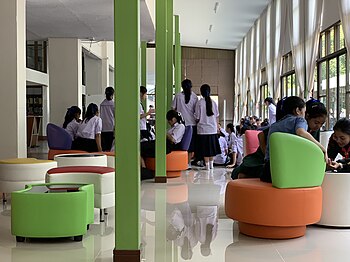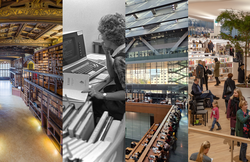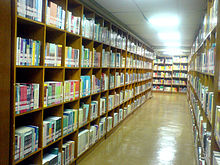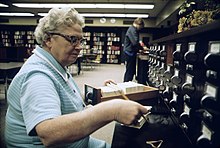This article has multiple issues. Please help improve it or discuss these issues on the talk page. (Learn how and when to remove these messages)
|

| Part of a series on |
| Library and information science |
|---|
 |
| HistoriesLibraries - Information |
| FocusArchives management - Collections management (Preservation) - Data management - Information management (cataloguing) - Knowledge management - Library management |
| CurationData - Metadata - Information - Documents - Artefacts - Knowledge |
| Interdisciplinary fieldsArchival science - Communication studies - Computer science - Data science - Documentation science - Epistemology - Library science - Information science - Science and technology studies |
| AreasAcademic - Archival - Legal - Health - Private - Public - School - Special |
A school library (or a school media center) is a library within a school where students, and sometimes their parents and staff have access to loan a variety of resources, often literary or digital. The goal of a school library or media center is to ensure that all members of the school community have equitable access "to books and reading, to information, and to information technology". A school library or media center "uses all types of media . . . is automated, and utilizes the Internet for information gathering."
School libraries are distinct from public libraries because they serve as "learner-oriented laboratories which support, extend, and individualize the school's curriculum... A school library serves as the center and coordinating agency for all material used in the school."
History of school libraries
Library services to schools have evolved since the late 1800s from public or state library book wagons, to informal classroom collections to what exists today. The latter part of the 19th century marked the beginning of the modern American library movement with the creation of the American Library Association (ALA) in 1876 by a group of librarians led by Melvil Dewey. In the early stages of development, school libraries were primarily made up of small collections with the school librarian primarily serving a clerical role.
Dewey wrote that "a broad conception at the end of the century of the work of the schools is simply this, to teach the children to think accurately, with strength and with speed. If it is in the school that they get their start, then where do they get their education?"
1920 marked the first effort by the library and education communities to evaluate school libraries with the publication of the Certain Report, which provided the first yardstick for evaluating school libraries.
By the 1950s, 40% of schools indicated the presence of classroom collections. Around 18% reported having centralized libraries. City schools reported 48%, and rural schools reported 12%. School libraries experienced another major push following the launch of Sputnik in 1957, which forced the United States to re-evaluate its priorities for math and science education. The National Defense Education Act (NDEA) of 1958 was a response to Sputnik, and Title III of the NDEA provided financial assistance for strengthening science, mathematics, and modern foreign language. As a result, the 1960s were one of the greatest periods of growth and development for school libraries due to an increased flow of money and support from the private sector and public funding for education. Most notable during this time was the Knapp School Libraries Project, which established model school library media centers across the country. Hundreds of new school libraries were expanded and renovated during this time.
Most recently, school libraries have been defined by two major guiding documents: Information Power (1988) and Information Power II (1998).
In 1999, the International Federation of Library Associations and Institutions (IFLA) published the globally important UNESCO School library Manifesto, which states: "The school library provides information and ideas that are fundamental to functioning successfully in today’s information and knowledge-based society. The school library equips students with life-long learning skills and develops the imagination, enabling them to live as responsible citizens" (para. 1).
The purpose of the school library

School library media centers in the 21st century can, and should be, hubs for increased student achievement and positive focused school reform.
—Kathleen D. Smith
The school library exists to provide a range of learning opportunities for both large and small groups, as well as individuals with a focus on intellectual content, information literacy, and the learner. In addition to classroom visits with collaborating teachers, the school library also serves as a learning space for students to do independent work, use computers, access the internet, use equipment and research materials; to host special events such as author visits and book clubs; and for tutoring and testing.
Researchers have demonstrated that school libraries have a positive impact on student achievement through the more than 60 studies that have been conducted in 19 U.S. states and one Canadian province. The major finding of these studies was that students with access to a well-supported school library media program with a qualified school library media specialist scored higher on reading assessments, regardless of their socio-economic statuses. In addition, a study conducted in Ohio revealed that 99.4% of students surveyed believed that their school librarians and school library media programs helped them succeed in school. A report that reported similar conclusions was compiled by Michele Lonsdale in Australia in 2003.
School libraries function as a central location for all of the information available, and a school librarian functions as the literary map to the resources and materials found within the library.
A school library functions as an opportunity for educators to work with librarians in support of a resource center for the students to be able to safely access the internet for both school work and interacting with each other. In her article "Tag! You're It!": Playing on the Digital Playground," Dianne de Las Casas discusses how today's youth is much more comfortable with technology than ever before and believes that “We need to advocate for regulations and laws that support education of young people rather than simply limiting their access to the Web.”
The school library media center program is a collaborative venture in which school library media specialists, teachers, and administrators work together to provide opportunities for the social, cultural, and educational growth of students. Activities that are part of the school library media program can take place in the school library media center, the laboratory classroom, through the school, and via the school library's online resources.
In Australia, school libraries have played a major role in the success of Reading Challenge programs initiated and funded by various State Governments. The Premier's Reading Challenge in South Australia, launched in 2003 by Premier Mike Rann (2002–11), has one of the highest participation rates in the world for reading challenges. It has been embraced by more than 95% of public, private, and religious schools.
The school library collection
School libraries are similar to public libraries in that they contain books, films, recorded sound, periodicals, realia, and digital media. These items are not only for the education, enjoyment, and entertainment of all members of the school community but also to enhance and expand the school's curriculum.
Budget
Budget is a critical component of building a school library collection, often allocated by its relevant governing body (e.g. the board of governors). It is important to utilize those funds for the best interest of the school community.
Staffing of the school library
In many schools, libraries are staffed by librarians, teacher-librarians, student volunteers, or school library media specialists or media coordinators who hold a specific library science degree. In some jurisdictions, school librarians are required to have specific certification and/or a teaching certificate.

The school librarian performs four leadership main roles: teacher, instructional partner, information specialist, and program administrator. In the teacher role, the school librarian develops and implements curricula relating to information literacy and inquiry. School librarians may read to children, assist them in selecting books, and assist with schoolwork. Many school librarians also teach technology skills, such as keyboarding and Microsoft and Google applications. Some school librarians see classes on a "flexible schedule". A flexible schedule means that rather than having students come to the library for instruction at a fixed time every week, the classroom teacher schedules library time when library skills or materials are needed as part of the classroom learning experience.

In the instructional partner role, school librarians collaborate with classroom teachers to create independent learners by fostering students' research, information literacy, technology, and critical thinking skills.
As information specialists, school librarians develop a resource base for the school by using the curriculum and student interests to identify and obtain library materials, organize and maintain the library collection in order to promote independent reading and lifelong learning. Materials in the library collection can be located using an Online Public Access Catalog (OPAC). Often these catalogs are web-based from which students can gain access both at school and from home.
This role also encompasses many activities relating to technology, including the integration of resources in a variety of formats: periodical databases, web sites, digital video segments, podcasts, blog and wiki content, digital images, and virtual classrooms. School librarians are often responsible for audio-visual equipment and are sometimes in charge of school computers and computer networks.
Many school librarians also perform clerical duties. They handle the circulating and cataloging of materials, facilitate interlibrary loans, shelve materials, and perform inventory.

Notable school librarians
- Laura Bush – Austin Independent School District
- Graham Gardner – Abingdon School
- Grant Lyons – Keystone School
- Laura Amy Schlitz – Park School of Baltimore
See also
- American Association of School Libraries (AASL)
- School Library Association (UK)
- Teacher-librarian
- Virtual school libraries in the United States
- Learning Resource Centre
- Hannah Logasa
Notes and references
- "AASL Standards for the 21st Century Learner" (PDF). American Association of School Librarians. p. 2. Archived from the original (PDF) on October 8, 2008. Retrieved August 29, 2022.
- Morris, B. (2013). Administering the school library media center. Westport, CT: Libraries Unlimited. (p.32).
- Morris, 2013, p.32
- Wiegand, Wayne A. American Public School Librarianship: A History. Baltimore: Johns Hopkins University Press, 2021
- ^ Michie, Joan S; Holton, Barbara (March 2005). "Fifty Years of Supporting Children's Learning: A History of Libraries and Federal Legislation From 1953to 2000" (PDF). U.S. Department of Education. Archived from the original (PDF) on July 26, 2022. Retrieved August 29, 2022.
- Dewey, M. (1920). What a library should be and what it can do. In A. E. Bostwick (Ed.). The library and society: Classics of American librarianship (pp. 75-78). New York: H.W. Wilson.
- Charles C. Certain Committee. (1986). Standard library organization and equipment for secondary schools of different sizes. In Melvil M. Bowie (Comp.), Historic Documents of school libraries (pp.34-51). Littleton, CO: Hi Willow Research and Publishing. (Original work published 1920, Chicago: American Library Association)
- Michie, Joan S., et al. "Fifty Years of Supporting Children's Learning: A History of Public School Libraries and Federal Legislation from 1953 to 2000. NCES 2005-311." (March 1, 2005): ERIC, EBSCOhost (accessed March 1, 2018).
- Boardman, Edna (September–October 1994). "The Knapp School Libraries Project: The Best $1,130,000 Ever Spent on School Libraries". Book Report. 13 (2): 17–19. ISSN 0731-4388. ERIC # EJ489785.
- American Association of School Librarians & Association for Educational Communications and Technology. (1988). Information power: Guidelines for school library media programs. Chicago: American Library Association.
- American Association of School Librarians & Association for Educational Communications and Technology. (1998). Information power: Building partnerships for learning. Chicago: American Library Association.
- Smith, K. (2002). "Building Student Learning Through School Libraries." Statement delivered at the White House Conference on School Libraries, available from: "IMLS - News & Events - Conferences". Archived from the original on 2008-09-16. Retrieved 2008-12-06.
- Morris, 2004
- Todd, R., Kuhlthau, C., & OELMA. (2014). Student Learning through Ohio School Libraries : The Ohio Research Study. Available online at: "OELMA Student Learning". Archived from the original on 2004-08-29. Retrieved 2008-12-06.
- Lonsdale, M. (2003). Impact of school libraries on student achievement: A review of the research. Camberwell, Victoria, Australia: Australian Council for Educational Research. Available online at http://www.asla.org.au/site/DefaultSite/filesystem/documents/research.pdf
- Felmley, D. (2010). How far should courses in normal schools and teachers’ colleges seek to acquaint all teachers with the ways of organizing and using school libraries?. Journal of Proceedings and Addresses of the Forty-Sixth Annual Meeting Held at Cleveland, Ohio, 1087-1095. doi:10.1037/e597422010-207
- De las Casas, D. (2010). “Tag! you're it!”: playing on the digital playground. Knowledge Quest, 39(1), 80-82.
- Morris, 2004
- Center for National Policy, Washington DC, What States Can Do, May 2, 2012
- Bredenkamp, Paige. "Subject Guides & Tutorials: School Library Handbook: Collection Development". gowyld.libguides.com. Retrieved 2022-03-30.
- Morris, 2004; Thomas, M. J. & Perritt, P.H. (2003, December 1). A Higher standard: Many states have recently revised their certification requirements for school librarians. School Library Journal. Available online at http://www.schoollibraryjournal.com/article/CA339562.html?industryid=47056
External links
- Unesco School Library Manifesto
- American Association of School Librarians
- School Library Journal
- School Library Media Activities Monthly
- Resources for School Libraries
- Virtual Learning Resources Center
- The Hub: Campaign for Quality School Libraries
- Australian School Library Association
- Directory of portuguese online school libraries catalogs
- Suomen koulukirjastoyhdistys
- Siu-Runyan, Yvonne. "Public and School Libraries in Decline: When We Need Them." (Archive). National Council of Teachers of English (NCTE).